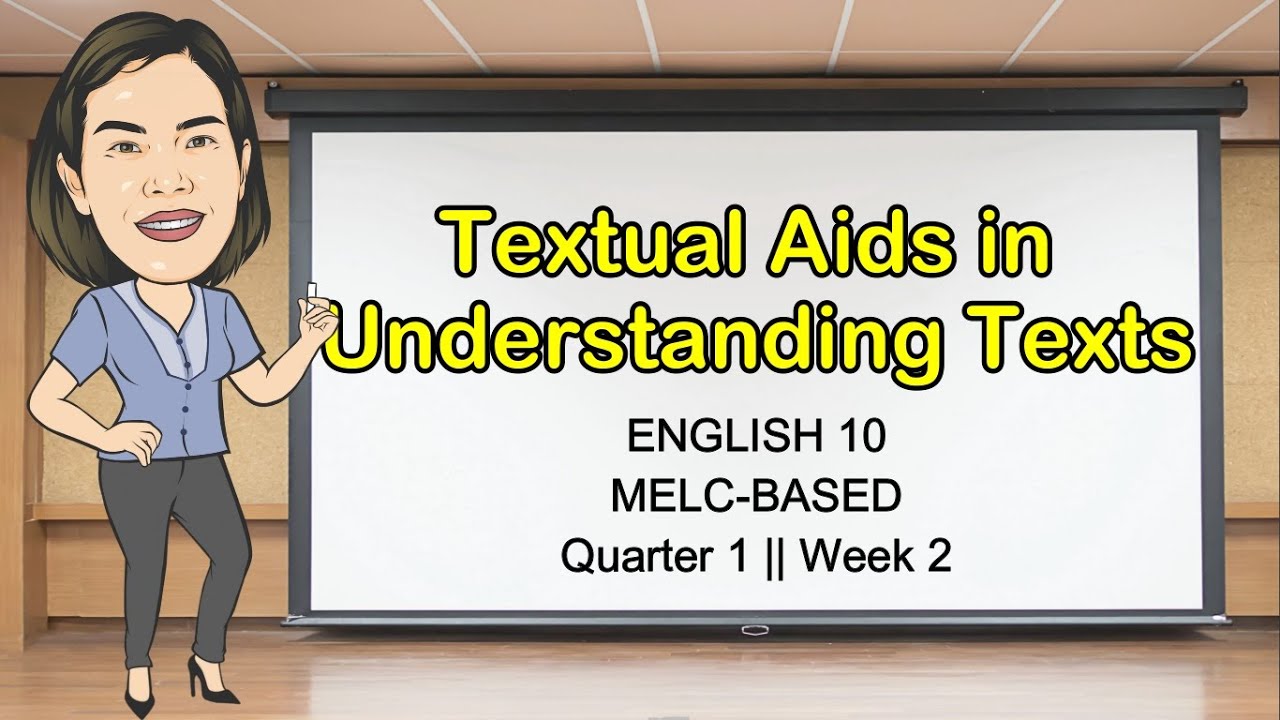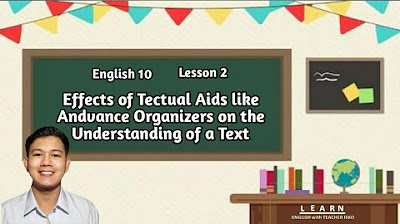TEXTUAL AIDS || Grade10|| MELC-based VIDEO LESSON | QUARTER 1| MODULE 2
Summary
TLDRThis educational video discusses the importance of textual aids in enhancing text comprehension. It covers advanced organizers, titles, and non-linear illustrations, explaining their roles in directing attention, providing supplementary information, and improving retention. Examples of various graphic organizers and their applications in learning are also provided.
Takeaways
- 😀 Textual aids are non-textual elements that help readers understand the content of a text.
- 🔍 Textual aids can include titles, subtitles, bold, italicized, and underlined texts, as well as illustrations, maps, tables, graphs, and charts.
- 📚 Advanced organizers are used by teachers to introduce a lesson and guide learners on how to think about it.
- 🎬 A movie trailer is an example of an advanced organizer, providing a preview of what to expect.
- 📈 Expository advanced organizers give students a broad idea of the lesson's purpose before it begins.
- 📖 Narrative advance organizers involve storytelling at the beginning of a class to relate to important concepts.
- 👀 Skimming and picture walks are types of advanced organizers that help students become familiar with material before reading it thoroughly.
- 🌳 Graphic organizers structure information visually or in pictures, aiding in understanding complex topics like habitats in a tropical rainforest.
- 📊 Various graphic organizers like persuasion maps, sequence charts, and story maps are used to improve comprehension and note-taking.
- 🏷 Titles improve comprehension and memorability of text by directing attention to important information.
- 📊 Non-linear illustrations such as flow charts, graphs, and graphic organizers help in understanding complex relationships and data.
Q & A
What is the main focus of the video script?
-The main focus of the video script is to discuss the importance and types of textual aids in enhancing the understanding of a text.
What are textual aids?
-Textual aids refer to non-textual elements that help readers understand the content of the text. They can include titles, subtitles, bold, italicized, and underlined texts, as well as non-textual elements like illustrations, maps, tables, graphs, and charts.
What is the purpose of using advanced organizers in teaching?
-Advanced organizers are used to introduce a lesson and guide learners on how to think about it. They help direct the reader's attention to important ideas in the text and provide more information as a supplement to what is already written.
What are some examples of advanced organizers?
-Examples of advanced organizers include expository organizers, narrative organizers, skimming, picture walks, and graphic organizers such as persuasion maps, sequence charts, story maps, biography graphic organizers, learning maps, vocabulary graphic organizers, problem-solving organizers, timeline graphic organizers, t-charts, hierarchy charts, star diagrams, cluster diagrams, lotus diagrams, cause and effect graphic organizers, mind maps, double bubble maps, and Venn diagrams.
How do titles help in text comprehension?
-Titles improve comprehension and memorability of text by directing the reader's attention to important information and providing a context for what the text is about.
What is the role of non-linear illustrations in textual aids?
-Non-linear illustrations, such as flow charts, graphs, and graphic organizers, help in visualizing complex information and relationships, making it easier for readers to understand and retain the content.
What is a KWL chart and how is it used in learning?
-A KWL chart is a learning tool where students divide a page into three columns: 'K' for what they Know, 'W' for what they Want to know, and 'L' for what they Learned. It helps students think about what they already know and what they want to learn, thus increasing their interest and focus.
How do analogies function as advanced organizers?
-Analogies, which are comparisons of two things that are alike in some way, can be used as advanced organizers to help students relate new topics to something familiar, thereby enhancing their understanding.
What are the parts of a bar graph?
-The parts of a bar graph include the title, labels, and bars. The title tells what the graph is about, labels indicate what kinds of facts are listed, and the bars show the data with their height representing the value.
What is a pie chart and what does it represent?
-A pie chart is a circular statistical graphic which is divided into slices to illustrate numerical proportion. It shows how a whole is divided into parts, with each slice representing a percentage of the total.
What is the purpose of a pictograph?
-A pictograph is a type of graph that uses images, icons, or symbols to represent data. It is used to represent the frequency of data in a visually appealing and easily understandable way.
Outlines

Cette section est réservée aux utilisateurs payants. Améliorez votre compte pour accéder à cette section.
Améliorer maintenantMindmap

Cette section est réservée aux utilisateurs payants. Améliorez votre compte pour accéder à cette section.
Améliorer maintenantKeywords

Cette section est réservée aux utilisateurs payants. Améliorez votre compte pour accéder à cette section.
Améliorer maintenantHighlights

Cette section est réservée aux utilisateurs payants. Améliorez votre compte pour accéder à cette section.
Améliorer maintenantTranscripts

Cette section est réservée aux utilisateurs payants. Améliorez votre compte pour accéder à cette section.
Améliorer maintenantVoir Plus de Vidéos Connexes

English 10 | Quarter 1 | Week 2 Textual Aids in Understanding Text

TEXTUAL AIDS IN UNDERSTANDING TEXTS || Quarter 1 Week 2 || English 10 || MELC-BASED || Aizie Dumuk

TEXTUAL AIDS || GRADE 10 || MELC-based VIDEO LESSON | QUARTER 1 | Module 2

Textual Aids - English 10 - Lesson 2

Grade 10 English Q1 Ep3: Textual Aids in Understanding Text

Grade 10 English Q1 Ep4: Textual Aids
5.0 / 5 (0 votes)
